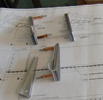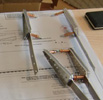


random user submitted photo
Fuel Injection return circuit
4 posts
• Page 1 of 1
Fuel Injection return circuit
As with many/most fuel injected engines, Rotax 912i, 914 & 915T require a return circuit of excess gasoline - not delivered by the injectors. The excess fuel returns to the fuel tank. This circuit requires a backflow cutoff - a one way valve - to prevent fuel coming from the tank into the return circuit. Rotax recommends such a circuit but does not detail one or provide one.
When I look at schematics of examples of such circuits I can't fully understand them because it's not just a single path: source, fuel line, one-valve, fuel line, tank. There's more going on, some kind of parallelism in lines of the circuit.
Who knows of a explanatory example? And of a particular type/capacity/... of valve to use?
[Related: I'm going to route the return thru the overflow space (small metal box at the top of the firewall) that contains the tank neck and then directly thru that neck not too far below the gas cap, on the theory that feeding it back lower in the tank risks putting it below the surface of the fuel and thus providing a back pressure. On the other hand, routing as I am means that return fuel will be running down the non-liquid gas above the fuel. Since the tank has a breather this means that highly aromatic gasoline may be constantly mixing with some air and thus either degrade (e.g. lose oxygen or additives) or increase the fire risk at the breather.]
Thank you,
Peter Schwenn
When I look at schematics of examples of such circuits I can't fully understand them because it's not just a single path: source, fuel line, one-valve, fuel line, tank. There's more going on, some kind of parallelism in lines of the circuit.
Who knows of a explanatory example? And of a particular type/capacity/... of valve to use?
[Related: I'm going to route the return thru the overflow space (small metal box at the top of the firewall) that contains the tank neck and then directly thru that neck not too far below the gas cap, on the theory that feeding it back lower in the tank risks putting it below the surface of the fuel and thus providing a back pressure. On the other hand, routing as I am means that return fuel will be running down the non-liquid gas above the fuel. Since the tank has a breather this means that highly aromatic gasoline may be constantly mixing with some air and thus either degrade (e.g. lose oxygen or additives) or increase the fire risk at the breather.]
Thank you,
Peter Schwenn
6514 41st Ave
University Park MD 20782
240-602-6931
N16XN under construction
N32SX @ KCGS (912iS being installed)
http://www.schwenn.com
Eaa4 - KCGS College Park MD
University Park MD 20782
240-602-6931
N16XN under construction
N32SX @ KCGS (912iS being installed)
http://www.schwenn.com
Eaa4 - KCGS College Park MD
- pschwenn
- Posts: 25
- Joined: Fri Jul 03, 2015 8:22 pm
- Location: 6514 41st Avenue, University Park, MD 20782
Re: Fuel Injection return circuit
Hi, Disclaimer: I am not a qualified mechanic of any description, however I have been "playing" with internal combustion engines (petrol & diesel) for about 55 years or so.
All fuel injected engines, that I have ever come across, return "surplus" fuel to the tank - I have yet to see a return line with a non return valve. Reason - the return fuel is under, relativly low, pressure so there is no possibility of a back flow. The delivery point, of the returning fuel to the tank, is not critical but if there is a choice, into the top of the tank or fuel tank fill tube.
The Rotax 91 range (including carburettor models) all have a fuel return line. The carburetor models return line is for a different reason to the injected models but the principals of the return itself are similar (no return valve required).
All fuel injected engines, that I have ever come across, return "surplus" fuel to the tank - I have yet to see a return line with a non return valve. Reason - the return fuel is under, relativly low, pressure so there is no possibility of a back flow. The delivery point, of the returning fuel to the tank, is not critical but if there is a choice, into the top of the tank or fuel tank fill tube.
The Rotax 91 range (including carburettor models) all have a fuel return line. The carburetor models return line is for a different reason to the injected models but the principals of the return itself are similar (no return valve required).
- Skippydiesel
- Posts: 672
- Joined: Tue Jul 06, 2021 6:24 am
Re: Fuel Injection return circuit
Hi skippy
Good input. I’m putting the one way check valve on the inside of the firewall because I don’t want the possibility of fuel flowing back into the engine compartment, uncontrolled, in the event of a break in the fuel return line. Typically these valves require about 2psi to open, and will close under no pressure, so should serve the function well.
In normal operation it serves neither function nor impediment. The valves aren’t terribly expensive so it completes the sealing off of the engine compartment from any fuel by shutting only the main fuel valve. The lack of flow after that will shut the check valve.
Gordon
Good input. I’m putting the one way check valve on the inside of the firewall because I don’t want the possibility of fuel flowing back into the engine compartment, uncontrolled, in the event of a break in the fuel return line. Typically these valves require about 2psi to open, and will close under no pressure, so should serve the function well.
In normal operation it serves neither function nor impediment. The valves aren’t terribly expensive so it completes the sealing off of the engine compartment from any fuel by shutting only the main fuel valve. The lack of flow after that will shut the check valve.
Gordon
Waiex 158 New York. N88YX registered.
3.0 Liter Corvair built, run, and installed.
Garmin panel, Shorai LiFePo batteries.
3.0 Liter Corvair built, run, and installed.
Garmin panel, Shorai LiFePo batteries.
- GordonTurner
- Posts: 653
- Joined: Tue Feb 21, 2012 1:14 am
- Location: NY, NY
Re: Fuel Injection return circuit
Further comment:
The principal behind Sonex is simplicity.
Its a very human failing to want to enhance/modify, make complex.
How often have you heard of a leak from a return line?
A properly installed return line has, I suggest, almost nil chance of leaking in normal service (if rubber hose, replace every 5 years in line with Rotax recommendation's).
Your valve may operate flawlessly when first installed. however all mechanical devices are subject to wear/tear and failure. What if it jams closed - fuel pressure will climb - possible rupture - fuel over hot engine - not a good look!
The principal behind Sonex is simplicity.
Its a very human failing to want to enhance/modify, make complex.
How often have you heard of a leak from a return line?
A properly installed return line has, I suggest, almost nil chance of leaking in normal service (if rubber hose, replace every 5 years in line with Rotax recommendation's).
Your valve may operate flawlessly when first installed. however all mechanical devices are subject to wear/tear and failure. What if it jams closed - fuel pressure will climb - possible rupture - fuel over hot engine - not a good look!
- Skippydiesel
- Posts: 672
- Joined: Tue Jul 06, 2021 6:24 am
4 posts
• Page 1 of 1
Who is online
Users browsing this forum: No registered users and 14 guests







